Icosidigon
| Regular icosidigon | |
|---|---|
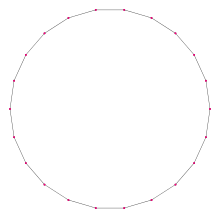 A regular icosidigon | |
| Type | Regular polygon |
| Edges and vertices | 22 |
| Schläfli symbol | {22}, t{11} |
| Coxeter diagram |
|
| Symmetry group | Dihedral (D22), order 2×22 |
| Internal angle (degrees) | ≈163.636° |
| Dual polygon | Self |
| Properties | Convex, cyclic, equilateral, isogonal, isotoxal |
In geometry, an icosidigon (or icosikaidigon) or 22-gon is a twenty-two-sided polygon. The sum of any icosidigon's interior angles is 3600 degrees.
Regular icosidigon
The regular icosidigon is represented by Schläfli symbol {22} and can also be constructed as a truncated hendecagon, t{11}.
The area of a regular icosidigon is: (with t = edge length)
Construction
As 22 = 2 × 11, the icosidigon can be constructed by bisecting a regular hendecagon. However, the icosidigon is not constructible with a compass and straightedge, since 11 is not a Fermat prime. Consequently, the icosidigon cannot be constructed even with an angle trisector, because 11 is not a Pierpont prime. It can, however, be constructed with the neusis method.
Dissection

Coxeter states that every zonogon (a 2m-gon whose opposite sides are parallel and of equal length) can be dissected into m(m-1)/2 parallelograms. In particular this is true for regular polygons with evenly many sides, in which case the parallelograms are all rhombi. For the regular icosidigon, m=11, and it can be divided into 55: 5 sets of 11 rhombs. This decomposition is based on a Petrie polygon projection of a 11-cube.[1]
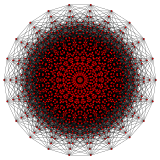 11-cube |
 |
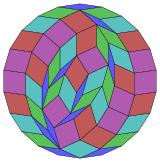 |
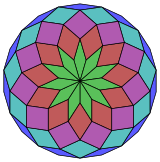 |
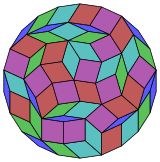 |
Related polygons
An icosidigram is a 22-sided star polygon. There are 4 regular forms given by Schläfli symbols: {22/3}, {22/5}, {22/7}, and {22/9}. There are also 7 regular star figures using the same vertex arrangement: 2{11}, 11{2}.
There are also isogonal icosidigrams constructed as deeper truncations of the regular hendecagon {11} and hendecagrams {11/2}, {11/3}, {11/4} and {11/5}.[2]
| Isogonal truncations of regular hendecagon and hendecagrams | |||||||||||
|---|---|---|---|---|---|---|---|---|---|---|---|
| Quasiregular | Isogonal | Quasiregular | |||||||||
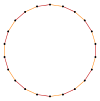 t{11}={22} |
 |
 |
 |
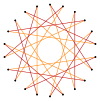 |
 |
 t{11/10}={22/10} | |||||
 t{11/2}={22/2} |
 {11/9}:t6 |
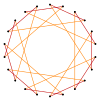 {11/9}:t5 |
 {11/9}:t4 |
 {11/9}:t3 |
 {11/9}:t2 |
 t{11/9}={22/9} | |||||
 t{11/3} = {22/3} |
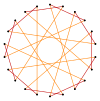 {11/3}:t2 |
 {11/3}:t3 |
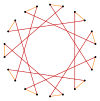 {11/3}:t4 |
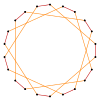 {11/3}:t5 |
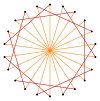 {11/3}:t6 |
 t{11/8}={22/8} | |||||
 t{11/4}={22/4} |
 {11/7}:t6 |
 {11/7}:t5 |
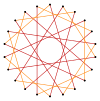 {11/7}:t4 |
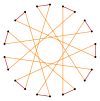 {11/7}:t3 |
 {11/7}:t2 |
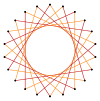 t{11/7}={22/7} | |||||
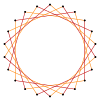 t{11/5} = {22/5} |
 {11/5}:t2 |
 {11/5}:t3 |
 {11/5}:t4 |
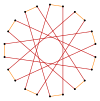 {11/5}:t5 |
 {11/5}:t6 |
 t{11/6}={22/6} | |||||
References
- ↑ Coxeter, Mathematical recreations and Essays, Thirteenth edition, p.141
- ↑ The Lighter Side of Mathematics: Proceedings of the Eugène Strens Memorial Conference on Recreational Mathematics and its History, (1994), Metamorphoses of polygons, Branko Grünbaum